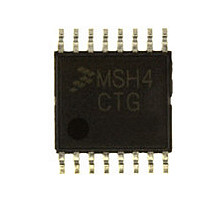MC9S08SH4CTG Freescale, MC9S08SH4CTG Datasheet - Page 160

MC9S08SH4CTG
Manufacturer Part Number
MC9S08SH4CTG
Description
Manufacturer
Freescale
Datasheet
1.MC9S08SH4CTG.pdf
(338 pages)
Specifications of MC9S08SH4CTG
Cpu Family
HCS08
Device Core Size
8b
Frequency (max)
40MHz
Interface Type
I2C/SCI/SPI
Total Internal Ram Size
256Byte
# I/os (max)
13
Number Of Timers - General Purpose
1
Operating Supply Voltage (typ)
3.3/5V
Operating Supply Voltage (max)
5.5V
Operating Supply Voltage (min)
2.7V
On-chip Adc
8-chx10-bit
Instruction Set Architecture
CISC
Operating Temp Range
-40C to 85C
Operating Temperature Classification
Industrial
Mounting
Surface Mount
Pin Count
16
Package Type
TSSOP
Program Memory Type
Flash
Program Memory Size
4KB
Lead Free Status / RoHS Status
Compliant
Available stocks
Company
Part Number
Manufacturer
Quantity
Price
Company:
Part Number:
MC9S08SH4CTG
Manufacturer:
FREESCAL
Quantity:
96
Company:
Part Number:
MC9S08SH4CTG
Manufacturer:
Freescale
Quantity:
8 727
- Current page: 160 of 338
- Download datasheet (4Mb)
Chapter 10 Internal Clock Source (S08ICSV2)
The CLKS bits can also be changed at anytime, but the RDIV bits must be changed simultaneously so that
the resulting frequency stays in the range of 31.25 kHz to 39.0625 kHz. The actual switch to the newly
selected clock will not occur until after a few full cycles of the new clock. If the newly selected clock is
not available, the previous clock will remain selected.
10.4.3
The BDIV bits can be changed at anytime and the actual switch to the new frequency will occur
immediately.
10.4.4
The low power bit (LP) is provided to allow the FLL to be disabled and thus conserve power when it is not
being used. However, in some applications it may be desirable to enable the FLL and allow it to lock for
maximum accuracy before switching to an FLL engaged mode. Do this by writing the LP bit to 0.
10.4.5
When IRCLKEN is set the internal reference clock signal will be presented as ICSIRCLK, which can be
used as an additional clock source. The ICSIRCLK frequency can be re-targeted by trimming the period
of the internal reference clock. This can be done by writing a new value to the TRIM bits in the ICSTRM
register. Writing a larger value will slow down the ICSIRCLK frequency, and writing a smaller value to
the ICSTRM register will speed up the ICSIRCLK frequency. The TRIM bits will effect the ICSOUT
frequency if the ICS is in FLL engaged internal (FEI), FLL bypassed internal (FBI), or FLL bypassed
internal low power (FBILP) mode. The TRIM and FTRIM value will not be affected by a reset.
Until ICSIRCLK is trimmed, programming low reference divider (RDIV) factors may result in ICSOUT
frequencies that exceed the maximum chip-level frequency and violate the chip-level clock timing
specifications (see the
If IREFSTEN is set and the IRCLKEN bit is written to 1, the internal reference clock will keep running
during stop mode in order to provide a fast recovery upon exiting stop.
All MCU devices are factory programmed with a trim value in a reserved memory location. This value can
be copied to the ICSTRM register during reset initialization. The factory trim value does not include the
FTRIM bit. For finer precision, the user can trim the internal oscillator in the application and set the
FTRIM bit accordingly.
10.4.6
The ICS module can support an external reference clock with frequencies between 31.25 kHz to 5 MHz
in all modes. When the ERCLKEN is set, the external reference clock signal will be presented as
ICSERCLK, which can be used as an additional clock source. When IREFS = 1, the external reference
clock will not be used by the FLL and will only be used as ICSERCLK. In these modes, the frequency can
be equal to the maximum frequency the chip-level timing specifications will support (see the
Overview
160
chapter).
Bus Frequency Divider
Low Power Bit Usage
Internal Reference Clock
Optional External Reference Clock
Device Overview
MC9S08SH8 MCU Series Data Sheet, Rev. 3
chapter).
Freescale Semiconductor
Device
Related parts for MC9S08SH4CTG
Image
Part Number
Description
Manufacturer
Datasheet
Request
R

Part Number:
Description:
TOWER ELEVATOR BOARDS HARDWARE
Manufacturer:
Freescale Semiconductor
Datasheet:

Part Number:
Description:
TOWER SERIAL I/O HARDWARE
Manufacturer:
Freescale Semiconductor
Datasheet:

Part Number:
Description:
LCD MODULE FOR TWR SYSTEM
Manufacturer:
Freescale Semiconductor
Datasheet:

Part Number:
Description:
DAUGHTER LCD WVGA I.MX51
Manufacturer:
Freescale Semiconductor
Datasheet:

Part Number:
Description:
TOWER SYSTEM BOARD MPC5125
Manufacturer:
Freescale Semiconductor
Datasheet:

Part Number:
Description:
KIT EVALUATION I.MX51
Manufacturer:
Freescale Semiconductor
Datasheet:

Part Number:
Description:
KIT DEVELOPMENT WINCE IMX25
Manufacturer:
Freescale Semiconductor
Datasheet:

Part Number:
Description:
TOWER SYSTEM KIT MPC5125
Manufacturer:
Freescale Semiconductor
Datasheet:

Part Number:
Description:
TOWER SYSTEM BOARD K40X256
Manufacturer:
Freescale Semiconductor
Datasheet:

Part Number:
Description:
TOWER SYSTEM KIT K40X256
Manufacturer:
Freescale Semiconductor
Datasheet:

Part Number:
Description:
Microcontrollers (MCU) MX28 PLATFORM DEV KIT
Manufacturer:
Freescale Semiconductor
Datasheet:

Part Number:
Description:
MCU, MPU & DSP Development Tools IAR KickStart Kit for Kinetis K60
Manufacturer:
Freescale Semiconductor
Datasheet:

Part Number:
Description:
24BIT HDMI MX535/08
Manufacturer:
Freescale Semiconductor
Datasheet:
Part Number:
Description:
Manufacturer:
Freescale Semiconductor, Inc
Datasheet:
Part Number:
Description:
Manufacturer:
Freescale Semiconductor, Inc
Datasheet:











